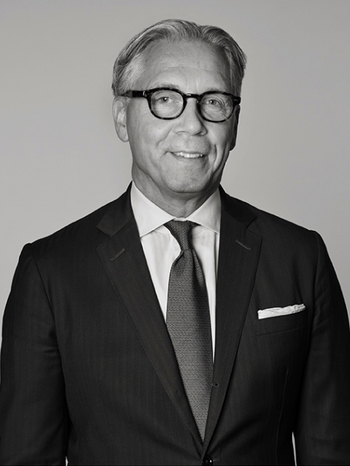Important Winter Sale: Alexander Calder, Untitled
Important Winter Sale presents
Alexander Calder, Untitled
“When everything goes right, a mobile is a piece of poetry that dances with the joy of life and surprise.” Quote E. Hutton and O. Wick (eds), Calder, London 2004, p. 261.
The auction's insect-like sculpture with its long antennae sweeps in wide movements. The mobile can turn horizontally through 360° and move vertically. All parts are separate from each another and play an equally important part in the intricate mechanism. Alexander Calder invented the moving sculpture, or mobile, as his friend Marcel Duchamp dubbed it. He wanted to bring three-dimensional works of art to life, freeing them from their locked position to move around the room as well. A motor powered his first mobile (1931), but in the early 1930s, he devised a way of using air currents to make the sculpture move around the room under its own power. In perfect balance, sensitive to the slightest gust of wind, the sculptures floated in the air, either hanging from the ceiling or leaning on static abstract iron sculptures that Calder called stabilisers. An exhalation or gentle movement of a finger would also be enough to make them perform their airborne feats. As they move, they change shape and cast interesting shadows. Some of the larger hanging mobiles could even sing as they touched each other, like frozen leaves in the wind.

Alexander Calder, who also was an engineer, was part of the avant-garde in Paris in the 1920s and 1930s, when Surrealism and Dada, as well as abstract art, were in the spotlight. Inspired by Piet Mondrian, he stuck to the primary colours - red, blue and yellow.
One of his most significant works, Circus Calder, which he performed for Parisian friends in a two-hour show, is now on permanent display at the Whitney Gallery in New York, where animals and acrobats in steel wire, metal and fabric take over the ring. It is said that Calder always had some wire in his pocket to sketch new ideas.
The 1940s were a significant period in Alexander Calder's artistic career. In 1943, MoMA staged a retrospective exhibition of his work that was a great success with the public and was to have a decisive influence on Calder's future career. In 1946, Duchamp organised an exhibition of Calder's work at the Galerie Louis Carré in Paris, featuring mainly hanging and standing mobiles. Jean-Paul Sartre wrote the foreword to the catalogue.
In the 1950s, Calder went monumental. Such sculptures are now placed outside several of the most important museums. One example is the 13-metre high motorised mobile "The Four Elements" outside the Moderna Museet in Stockholm and "Janey-Waney" in the Danish art museum Louisiana sculpture park. His tallest sculpture, the 20.5-metre "El Sol Rojo", was created for the Summer Olympics in Mexico City.
The untitled work coming up for sale was acquired at the Buchholz Gallery in 1949 at the exhibition "Alexander Calder". During the 1930s, Curt Valentin worked as an art dealer at the Buchholz Gallery in Berlin. In 1937 he emigrated to the United States with a sufficient number of works by German modernists to open a gallery under the same name in New York. Valentin organised many important exhibitions and associated many of the most renowned artists with his gallery. His affection for sculpture was evident in the artists and exhibitions he chose.

The work is sold at the Important Winter Sale.
Estimate 2 000 000 - 2 500 000 SEK.
Viewing: December 1 – 6th, Berzelii Park, Stockholm.
Open: Mon–Fri 11 AM – 18 PM, Sat – Sun 11 AM – 16 PM.
Auction: December 7 – 9th, Arsenalsgatan 2, Stockholm.
To the work
Explore the cataloge

Requests & condition reports Contact specialist

Tukholma
Lena Rydén
Johtava taideasiantuntija, moderni- ja 1800-luvun taide
+46 (0)707 78 35 71

Tukholma
Amanda Wahrgren
Asiantuntija, moderni taite ja grafiikka
+46 (0)702 53 14 89

Tukholma
Andreas Rydén
Varatoimitusjohtaja, Johtava asiantuntija, taide
+46 (0)728 58 71 39


























